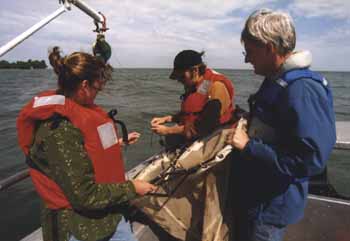
SUNY Brockport researchers look below the surface Among the more prominent activities at the State University College at Brockport is the biology department's faculty and student research studies of Lake Ontario and southern shore. No less than six faculty members, 15-20 undergraduate and graduate students, including department head Dr. Joseph Makarewicz, have active research projects based on the Great Lakes and related watershed issues. The research Makarewicz and his students and colleagues conduct is of such stature that it attracts funding from the U.S. Environmental Protection Agency, the National Science Foundation, New York State and Rochester Gas and Electric as well as several private foundations. The platform for much of the research is a 25-foot heavy gauge aluminum research vessel built especially for the SUNY Brockport biology department in 1985. Known as the RV Madtom -- named by students after a small (4-5") native species fish found in the tributaries, streams and creeks along the southern shore of Lake Ontario -- the boat is powered by twin 100 HP engines and outfitted with a crane and winch. The RV Madtom is used for limnology (the study of fresh water lakes and ponds) classes, water quality testing instruction, and other classes offered to biology and environmental science students. The boat is modeled after New England lobster craft, custom modified with a small cabin up front instead of midship to maximize the amount of available deck space for students and equipment. It is capable of motoring as much as seven miles off shore to conduct experiments. Professor Makarewicz' personal current research project is focused on an alien species, Cercopagis, commonly known as the fishhook waterflea. It is thought to have invaded the Great Lakes in the 1980s during the much publicized export of wheat to the Soviet Union. Ships carried the grain into the Caspian Sea where it was unloaded. The empty ships then took on seawater as ballast for the return trip. Several alien species were thereby introduced to the Great Lakes including the now infamous zebra mussel. Makarewicz has several colleagues working on the project including Betsy Damaske, a second year graduate student from Bloomfield. She came to Brockport to work on a master's degree following a short career working in a lab at Rochester's Columbia Analytical testing for heavy metals. She has since been awarded a Sea Grant fellowship. "I chose Brockport because we get lots of hands-on experience here. Students have an opportunity to really get involved in serious research. Working with Dr. Makarewicz allows me to study exotic species like the fishhook waterflea to see where it fits in the Lake Ontario food web. I study what it eats and what eats it." Under study Other SUNY Brockport research projects Jim Haynes' fisheries project intended to study the movement of salmon, steelhead and brown trout throughout the lakes. Funded by Sea Grant, the study has benefited the recovering New York sport fishing industry. He also studies benthic invertebrates -- insects which live on the lake bottom which may be affected or be affected by zebra mussels. Professor James Zolleg is a hydrologist who studies the flow of water, groundwater, lake levels, on-shore discharges and their effect on the lake. John Hunter is a plant ecologist whose research includes the status, influence and condition of wetlands along the embayments of the southern shore of the lake. Christopher Norment studies population and migratory behavior of water fowl. Mark Noll, a biological geo-chemist, is an expert on the chemistry of sedimentary deposits, especially toxic compounds such as mirex, a pesticide used to eradicate fire ants which was manufactured in the 1960s and 70s in Niagara Falls by Hooker Chemical. At the time, there was no restriction on dumping toxic chemicals like mirex into Lake Ontario, a practice the full impact of which is still being studied at Brockport and elsewhere. Research undertaken by the SUNY Brockport faculty and students is widely published in well regarded scientific publications such as the journals Science, Ecology, and the Journal of Great Lakes Research, Bioscience, Transactions of American Fisheries Society and Canadian journals such as Aquatic Biology and Fisheries. First year graduate student Corey Laxson, originally from Tonawanda, NY, is in the process of preparing a research manuscript based on his study of the Lake Ontario food web. His research, under the direction of Professor Makarewicz, was undertaken with the collaboration of scientists in Canada. They share data and will likely jointly publish their findings in one of these prominent journals. Laxson came to Brockport as a transfer student from Paul Smith's College near Saranac Lake, NY, where he was first encouraged to follow his life-long interest in aquatic biology. "It's pretty unique for an undergraduate to be able to get involved in this kind of research, that's why I transferred here," Laxson said. Laxson is now a graduate teaching assistant who looks forward to going on for a Ph.D. and a career in academia. About one-quarter to one-third of Brockport's students participating on Great Lakes research go on to earn Ph.D. degrees. A much larger number receive Master of Science degrees which, with a declining job market for Ph.D.s, they find environment-related jobs in government, regulatory agencies, and the private sector. Brockport trained students are now employed, for instance, by the EPA, New York State Department of Environmental Conservation, Monroe County Department of Health, Pure Waters, and area soil and water conservation districts. Research associate Betsy Damaske, for instance, hopes to find a job with a private sector environmental consulting agency working on water quality and watershed issues. In part due to the reputation and success of the biology departments training of environmental scientists, next year, SUNY Brockport will offer a separate degree in environmental science for the first time. Professor Makarewicz says, "I look forward to the development of the environmental science program. It's unique to Brockport. We do a good job with it, we have good people, a good location and good equipment." |
